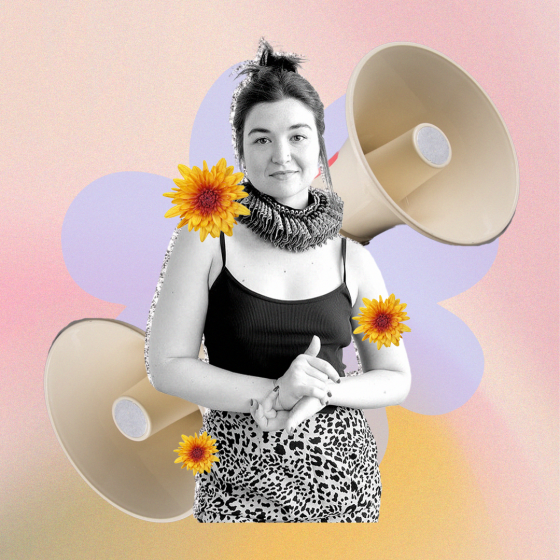It’s 2am and I’m in pain. Lonely, horrid, inexplicable pain, the kind that radiates from my lower back through my hips and down through my thighs, ending in a dull ache that claimed my kneecaps about five hours back. It feels a little like I took a long run today (if you knew me, you’d know how unlikely that is), but with the added addition of near-constant pelvic pain. Which is why I’m awake and writing this instead of sleeping, at 2am.
I know what you’re thinking: knee pain? I thought this was an article about endometriosis. It is. Hold onto your hats people, this is about to get real.
While endometriosis is, at its most base level, a gynaecological disease that can lead to heavy, painful periods, what many non-sufferers don’t realise is that it can also cause bowel and urinary symptoms, pain during sex, fatigue and infertility, as well as discomfort in all sorts of unexpected bodily locations – which provides a handy get-out-of-jail-free card for a medical establishment still more likely to misdiagnose or downplay women’s symptoms than to diagnose them quickly and effectively.
My own personal endo pick-n-mix includes the aforementioned hip, back and limb pain, chronic bowel symptoms that were initially dismissed as IBS, periods so painful they cause me to collapse, and adenomyosis, a related condition in which endometrial cells develop within the physical wall of the uterus, making traditional laparoscopic surgery less viable (apparently, removing my adeno would leave my uterus resembling “a Swiss cheese”. My specialist has a sense of humour, at least).
The Endo Epidemic
While endo is believed to affect as many as ten per cent of women, diagnosis still takes an average of seven to ten years, largely because it remains reliant on surgical investigation – and even when women are taken seriously, few hospitals are drowning in free surgery time. But while that’s a can of worms I’d happily empty all over the floor right now, what I’d like to focus on instead is what happens if, and when, you get that long overdue diagnosis. After all, endometriosis was last year confirmed to be among the 20 most painful chronic conditions one can suffer from – so effective treatment must be out there, right?
Wrong. While one might cynically suggest that a condition affecting ten per cent of men would benefit from a Swiss bank’s worth of research funding every day until a cure was found – with an extra frisson of urgency brought by a genuine risk of us all drowning in a flood of male tears – endo, as we know, only affects women. As such, what we have instead of cures and adequate pain relief are a host of treatments aimed first and foremost at preserving fertility above all else. Oh, and a funded study into how the condition affects the sex lives of sufferer’s male partners. No, really.
Five years on from my own diagnosis (which came 18 years after my symptoms first landed me in an ambulance as a teen), I’ve tried out a fair number of these so-called treatments, and I can confirm that they range from the benign and useless (paracetamol, anybody?) to the utterly brutal. So awful, in fact, that next month I’m having a consultation in which I will try, once again, to convince a doctor to consider my suitability for a hysterectomy. I’m 37.
I already have a child, am divorced, and have given repeated reassurances, ad naseum, that neither I nor my new partner want more children, but it is only now that I have an excellent, knowledgeable, sympathetic OBGYN willing to take my assurances on that as fact that I have an appointment at the menopause clinic to finally start the ball rolling. First, I had to prove my worth by undergoing a gamut of hormonal treatments, many of which have left me, and millions of women like me, battling with side-effects every bit as horrific as the disease they’re supposed to be treating.
Treatment by Trial
First up, the pill. For many women, the pill can and does work, with the mini-pill proving particularly effective for treating endo. But every pill comes with a range of side-effects, and none is suitable for all women, nor are any a targeted treatment for endometriosis itself. The same goes for other synthetic hormone options, such as progesterone supplementation, which can also prove very effective for those who can tolerate it. Sadly for me, eight pills and a course of progesterone treatment down, I can confirm that, sadly, I do not get on well with synthetic hormones. Next.
The six-month chemical menopause I underwent was my favourite treatment to date, though is inarguably one that many other women find utterly horrific. There are a range of drugs used for this approach, but all of them, in short, aim to block the production of oestrogen, effectively starving, and thus shrinking, endometriosis deposits. It is perhaps the most divisive treatment discussed among sufferers, but for me, it worked a treat. The monthly jabs were unpleasant, and I ditched the HRT quickly after it made me feel like I was losing my mind. But after that, I found that for six months I was blissfully pain-free, and the hot flushes, insomnia and weight gain I got as a side order paled in comparison to the pains that had previously left me bed-bound in agony for up to a week each month.
Sadly, however, one cannot remain in a chemical menopause indefinitely. Osteoporosis is just one of the long-term risks, so the treatment is largely viewed as a preparation for laparoscopic surgery – by shrinking endometriosis deposits, surgery is made easier. As such, many women find that undergoing a laparoscopy after a period of this form of treatment offers their best chance of getting pregnant, and can alleviate symptoms for a few months or even years. However, having been ruled out of suitability for surgery, I was back to square one and devastated. Here’s what you could have won…
I was assured, however, that a Mirena coil could potentially achieve the same painkilling effects by providing a lower dose of hormones than the pill in a more localised manner. Having reluctantly agreed, I set about having a Mirena inserted, but discovered that my tilted cervix – honestly, sometimes my vag is more attention-seeking than Gwyneth’s – the doctors struggled with insertion and the whole process was so excruciatingly painful that I collapsed and had to be taken by wheelchair to an emergency bed to recover. And you know what? I was embarrassed.
Punishment for Pain
I felt like I’d failed, yet again, at coping. At being a woman. Periods are supposed to be normal, so why couldn’t I handle them? Millions of women have coils, so why couldn’t I deal with insertion? Once again, like on so many occasions during my endo journey, I felt like I was being gaslighted, only this time by my own fanny instead of by a succession of GPs.
Which brings us to tonight. I still have the Mirena in, but my current pain is just one indicator that it’s not working. My pelvic pain and bowel symptoms have returned too, and while I don’t currently have periods, I do get horrid PMS, sore breasts, I’ve gained over a stone and I have terrible cyclical acne. I also need to wee every 22 minutes, which is fun. One person’s cure is another’s instrument of torture, I guess.
So, I’m hoping for a hysterectomy, which is a sentence no 37-year-old woman would choose to write if faced with a buffet of medical options. But I’ll only be given one if we can find an HRT option that negates the risk my bones will start snapping at 45. And while I don’t want to sound ungrateful – I know I’m one of the lucky ones to have been diagnosed at all, and to have a doctor who is willing to fight to find the right option for me – I can’t help but feel angry.
I’m angry that so many women are suffering without a cure. I’m angry that my fertility is seen as being more important than my right to live without pain when, surely, the prioritisation of those two things should be mine alone to make. But mostly, I’m angry that we still live in a world that gaslights women’s suffering, dismissing our physical pain as normal and our resulting emotional turmoil as hormonal.
Like so many sufferers, all I’m asking for is a month in which I’m not kept awake in agony by my uterus. And in a world where Viagra can be purchased in Boots and we conduct surveys into how the male ego is impacted by a female-only disease, I don’t think that’s too much to ask…









